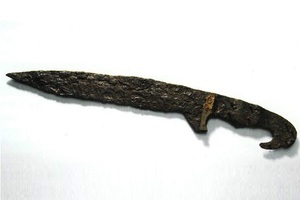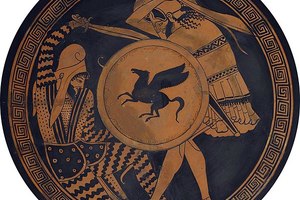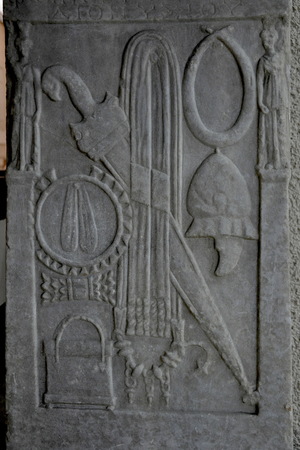Kopis
Kopis (Ancient Greek: κοπίς) is a type of bladed weapon with the cutting edge on the inner side of the blade, primarily designed for chopping strikes. The Greek word κόπτω means "to cut, sever." The kopis was mainly used by hoplites as a secondary weapon when their spear broke or when the enemy came too close.
Similar swords with the same construction were used by different peoples in different times, primarily varying in their names and the length of the blade. The earliest weapon of this type is considered to be the ancient Egyptian khopesh, which had a curved blade derived from a sickle. The khopesh could have an external or internal, and sometimes even a double-edged blade, and most importantly, it had a fairly long (50-60 cm) hilt, resembling a shortened polearm. On the other hand, the kopis had an inwardly curved sharpened edge and a saber-like hilt. This weapon likely originated in Sumer and later made its way to Greece through the Medes. It gained the most widespread use in Iberia.
Euripides and Plutarch used the term kopis to refer to a knife used for butchering meat. Xenophon referred to Persian and Egyptian swords as kopides. In his novel about Alexander the Great's campaign, the Roman author Curtius mentions kopides once in the battle against the Indians: "Slightly curved swords resembling sickles were called kopides, and they were used to chop off the elephants' trunks."
The kopis was most likely borrowed by the Greeks from the Persians in the 6th century BCE. Herodotus mentions this type of weapon used by Persian heavy cavalry. The length of the blades found in Greece varies from 53 to 70 cm archaeologically. Some specimens have a straight cutting edge, resembling a classic machete.
The kopis was carried on the left side in wooden sheaths covered with leather, suspended from the shoulder baldric.
Makhaira
Another word used to denote the same curved sword is makhaira (Ancient Greek: μάχαιρα), which in modern Greek means "knife." This word was widely used in antiquity to refer to various cutting objects, not just Greek combat swords. Xenophon used both "kopis" and "makhaira" to refer to the same type of sword, but from the context of his writings, it is clear that by "makhaira" he meant a cutting, rather than a thrusting blade, and by "kopis" he meant a curved sword:
"To inflict harm on the enemy, we prefer the curved sabre (μάχαιρα) to the straight sword (ξίφος), because the mounted warrior finds it more convenient to strike with a sabre (κοπίς) from a high position than with a sword."
Thus, makhaira is a broader term than kopis. In the Eastern Roman trials of the 10th century, the word "makhaira" simply meant a sword, referring to the text of the ancient Greek historian Polybius, who used the word makhaira to name Celtic-Iberian double-edged swords and genuinely Roman swords. In earlier texts, the Greeks referred to swords as xiphos (Ancient Greek: ξίφος).
Falcata
The name falcata (falcata) is not historically accurate. It emerged in the second half of the 19th century due to the liberty taken by one of the translators from Latin, who mistook the figurative descriptive expression "ensis falcatus" - "a sword curved like a sickle" - for the name of a type of weapon. The Romans themselves referred to this weapon as the "Spanish sword" - machaera Hispana.
According to legend, Iberian weapon-makers in the 3rd century BCE tested the quality of the steel in the following way: they placed the sword flat on their heads and bent it so that both ends touched their shoulders. When released, the sword should straighten back without any consequences. Despite repeatedly performing this trick, a good sword always restored its shape.
 Falcata. Museum in Madrid. 4th century BC
Falcata. Museum in Madrid. 4th century BC
Early examples of the falcata from the 5th-4th centuries BCE resemble Greek kopides with a hilt in the shape of a bird's head or an animal. Later, the artistic extravagances of the Greeks transitioned into a more functional configuration that was comfortable for the hand, while the blade acquired its final form.
The blade of the kopis (or falcata) widens toward the tip, causing the center of gravity to shift away from the hand. As a result, the kinetic energy of the strike increases, and thanks to the forward curve of the blade, the cutting ability significantly surpasses that of a straight sword. According to the Romans, no helmet or armor could withstand a strike from a falcata.
 Falcata with the remains of a scabbard. A museum in Madrid. 3rd century BC
Falcata with the remains of a scabbard. A museum in Madrid. 3rd century BC
Related topics

 Gallery
Gallery











